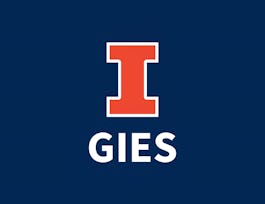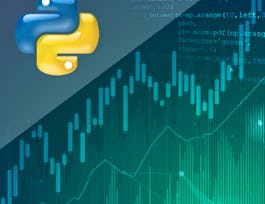This course, Machine Learning for Accounting with Python, introduces machine learning algorithms (models) and their applications in accounting problems. It covers classification, regression, clustering, text analysis, time series analysis. It also discusses model evaluation and model optimization. This course provides an entry point for students to be able to apply proper machine learning models on business related datasets with Python to solve various problems.



Machine Learning for Accounting with Python
This course is part of Accounting Data Analytics Specialization

Instructor: Linden Lu
Sponsored by Syrian Youth Assembly
9,461 already enrolled
(43 reviews)
What you'll learn
The concept of various machine learning algorithms.
How to apply machine learning models on datasets with Python in Jupyter Notebook.
How to evaluate machine learning models.
How to optimize machine learning models.
Skills you'll gain
Details to know

Add to your LinkedIn profile
8 assignments
See how employees at top companies are mastering in-demand skills

Build your subject-matter expertise
- Learn new concepts from industry experts
- Gain a foundational understanding of a subject or tool
- Develop job-relevant skills with hands-on projects
- Earn a shareable career certificate


Earn a career certificate
Add this credential to your LinkedIn profile, resume, or CV
Share it on social media and in your performance review

There are 9 modules in this course
In this module, you will become familiar with the course, your instructor and your classmates, and our learning environment. This orientation will also help you obtain the technical skills required to navigate and be successful in this course.
What's included
2 videos4 readings2 discussion prompts1 plugin
This module provides the basis for the rest of the course by introducing the basic concepts behind machine learning, and, specifically, how to perform machine learning by using Python and the scikit-learn machine learning module. First, you will learn about the basic types of machine learning. Next, you will learn an important step before applying machine learning algorithms, data pre-processing. Finally, you will learn how to leverage different types of machine learning algorithms in a Python script.
What's included
4 videos1 reading1 assignment1 programming assignment1 discussion prompt4 ungraded labs
This module introduces three machine learning algorithms. First, you will learn how linear regression can be considered a machine learning problem with parameters that must be determined computationally by minimizing a cost function. Next, you will learn Logistic Regression. Despite its name, Logistic Regression is a classification algorithm. Lastly, you will learn Decision Tree, which is a popular machine learning algorithm that can be used for both classification and regression. This module will dive deeper into the concept of machine classification, where algorithms learn from existing, labeled data to classify new, unseen data into specific categories; and, the concept of machine regression, where algorithms learn a model from data to make predictions for new, unseen continuous data. While these algorithms all differ in their mathematical underpinnings, they are often used for classifying numerical, text, and image data or performing regression in a variety of domains.
What's included
4 videos1 reading1 assignment1 programming assignment4 ungraded labs
This module introduces three more machine learning algorithms, k-nearest neighbors, support vector machine and random forest. All of them can be used for either classification or regression tasks.
What's included
4 videos1 reading1 assignment1 programming assignment4 ungraded labs
Model Evaluation is an integral component of any data analytics project. It helps to find out how well the model will work on predicting future (out-of-sample) data. This module introduces basic model evaluation metrics for machine learning algorithms. First, the evaluation metrics for regression is presented. Next the metrics and techniques to evaluate classification are introduced.
What's included
4 videos1 reading1 assignment1 programming assignment4 ungraded labs
This module introduces the techniques of model optimization. First, the basic techniques of feature selection is presented. Next, the technique of cross-validation is introduced, which can provide a more accurate evaluation on models. Finally, model selection, or hyperparameter tuning, which uses cross-validation, is introduced.
What's included
4 videos1 reading1 assignment1 programming assignment4 ungraded labs
In this module, you will start applying your new machine learning skills to an exciting data analytic topic: Text Analysis. First, we will review the process by which textual data is converted into numerical data that can be processed by a computer. Along with this are a number of new concepts that focus on manipulating these data to generate improved machine learning predictions. Second, we will apply machine learning algorithms, specifically classification, to text data. Finally, we will explore the more advanced concepts in text analysis and introduce a special kind of text classification: sentiment analysis.
What's included
4 videos1 reading1 assignment1 programming assignment4 ungraded labs
This module introduces clustering, where data points are assigned to sub groups of points based on some specific properties, such as spatial distance or the local density of points. While humans often find clusters visually with ease in a given data sets, computationally the problem is more challenging. This module starts by exploring the basic ideas behind this unsupervised learning technique. One of the most popular clustering techniques, K-means, is introduced. Next, a K-means case study is provided. Finally the density-based DBSCAN technique is introduced.
What's included
4 videos1 reading1 assignment1 programming assignment4 ungraded labs
This module introduces time and date data, which provide unique learning opportunities and challenges. First, we will discuss how to properly handle time and date features within a Python program. Next, we will extend this discussion to handle data indexed by time and date information, which is known as time series data.
What's included
4 videos3 readings1 assignment1 programming assignment3 ungraded labs1 plugin
Instructor

Offered by
Why people choose Coursera for their career




Learner reviews
43 reviews
- 5 stars
69.76%
- 4 stars
23.25%
- 3 stars
4.65%
- 2 stars
0%
- 1 star
2.32%
Showing 3 of 43
Reviewed on Jan 31, 2022
this great course , i'm accountant and i recomand for accountant to take all the course in order
Reviewed on Apr 16, 2022
This is a great introductory course on machine learning with really practical examples. It does not go too deep.
Reviewed on Aug 26, 2022
The course is a great one for Machine Learning Journey
Recommended if you're interested in Business

University of Illinois Urbana-Champaign

University of Illinois Urbana-Champaign

The Hong Kong University of Science and Technology

Open new doors with Coursera Plus
Unlimited access to 10,000+ world-class courses, hands-on projects, and job-ready certificate programs - all included in your subscription
Advance your career with an online degree
Earn a degree from world-class universities - 100% online
Join over 3,400 global companies that choose Coursera for Business
Upskill your employees to excel in the digital economy



